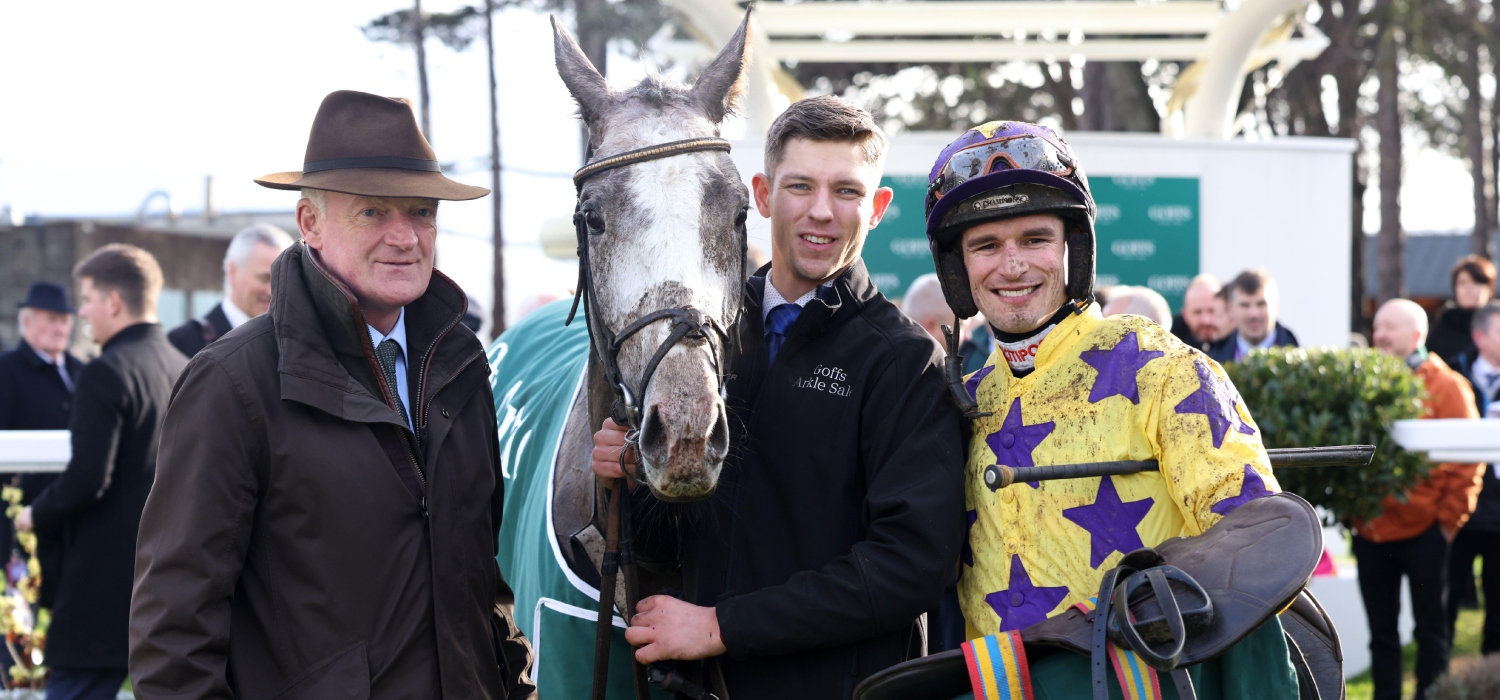
Cheltenham Trends analyst Matt Tombs is back with his first article of 2024 looking at different trainers’ pecking order…
Trainer’s Pecking Order
Last year I looked at some of the leading trainers at the Festival and which races they do well and badly in – which you can see here.
With ever more of the best horses concentrated in just a few hands, it is increasingly important to work out the pecking order of the horses in the mega-yards. The big question is, “Can the markets be trusted to point us in the direction of the stable no 1 at the Festival?”
This question applies to any race where a trainer is mob-handed but is especially important in the ‘novice’ races, where less is known about the horses. The vibes, both from the stable and the market, are more important, (I’m including the Bumper and the Triumph although neither are restricted to novices).
The only yards to have had more than 1 runner often enough recently to focus on are those of Willie Mullins, Gordon Elliott & Nicky Henderson.
I therefore researched the finishing order of horses from each of those yards when they ran more than 1 and compared them to the starting prices – to see whether the trainer / market knew their pecking order. (Where either none of the yard’s horses finished or their horses went off the same price, I’ve ignored those renewals.)
Dublin Racing Festival Review:
So many talking points in Ep 10: The Matchbook Cheltenham Trail, including:
– Willie Mullins domination
– Leopardstown Facilities
– Eight Grade 1s reviewed
– Eyecatchers@thespieler | @DanielHussey2
Donn McCleanYouTube: https://t.co/jVT4heQReL pic.twitter.com/l3ho2R8Gqx
— Matchbook Betting Exchange (@TeamMatchbook) February 6, 2024
Willie Mullins
The most important trainer is obviously Willie Mullins and his results show a stark difference between different Grade 1 novice races – and the dividing line is about distance.
In the races at short and intermediate trips, Willie invariably knows his pecking order by the time he gets to Cheltenham. At 3m he doesn’t.
This is illustrated in two ways in the 6 all-aged Grade 1 novice races. When Willie has run more than 1 horse, the percentage of occasions where his first string in the SP market has done best is, (56 renewals across the 6 races):
2 miles
- Supreme – 75%
- Arkle – 67%
Intermediate trips
- Baring Bingham – 78%
Turners – 70%
3 miles
- Albert Bartlett – 36%
Broadway – 29%
Focusing only on Willie’s winners of those races – when he has run more than 1, the percentage of occasions where that winner had the shortest SP of his runners is, (17 renewals across the 6 races):
2 miles
- Supreme – 100%
- Arkle – 100%
Intermediate trips
- Baring Bingham – 100%
- Turners – 100%
3 miles
- Albert Bartlett – 33%
- Broadway – 50%
Punters get deterred by Willie going mob-handed in the Grade 1 novice races. Over short and intermediate trips they shouldn’t – Willie knows his pecking order on the day.
The key to finding value in those races is working out at what point he knows who is A-teamer is. That varies every season. Sometimes Willie has a clear number 1 and a target for them from quite early on. Douvan was Willie’s Supreme and then Arkle horse from an early stage. The next best of the speedy novices went for the Baring Bingham / Turners and those that took Douvan on were Willie’s B-teamers.
Sometimes he will split his horses up based on the requirements of one, when another is flexible. In 2015 the vibes were that Vautour was his number 1 novice chaser and, having won the Supreme, would be his Arkle horse. However, Vautour was flexible as to trip and the then tearaway Un De Sceaux wasn’t – so Vautour went for the Turners.
With Willie’s training method getting ever more spring-focused, the date the pecking order gets settled is typically getting later. The Dublin Racing Festival is often that point now, especially in the novice hurdle divisions, where he knows less about the horses.
It is therefore a good time to be trying to establish Willie’s first strings for those short and intermediate trip races. For example, Ballyburn looks his best novice hurdler and debate will rage about whether he will go for the Supreme or Baring Bingham. My initial reaction was the Supreme would suit but I wouldn’t be confident that’s where he’ll actually run.
The Albert Bartlett and Broadway are very different. They are more about being battle-hardened and able to get into a rhythm on the day. Class matters of course but it’s a lesser part of the overall requirement. It’s therefore much harder for Willie to establish a pecking order in those 2 events.
Willie’s had quite a lot of fallers in the Broadway when he’s run more than 1 and I’m more open minded about how well he knows his pecking order in that race, despite the stats suggesting he doesn’t.
By contrast, the Albert Bartlett is really unpredictable because the test – typically a strongly run 3 miles on a sound surface – is very different to anything the vast majority of runners have tackled before. Given Willie tends to pitch novices who have been running at all sorts of trips into the Albert Bartlett, evaluating which will be suited by the test is especially important with his runners – don’t be afraid to back one of his supposed lesser lights.

Until recently, Willie had a modest win record in the Triumph but he’s trained 3 of the last 4 winners and his first string in the market has done best in each of the last 4 years, (overall this century his first string has done best on 7 out of 11 occasions.) Now Willie is developing the sort of strength with juveniles he’s long had with novices, I suspect he’ll typically know his pecking order in the Triumph.
Historically there has been a really strong trend about Willie’s Bumper horses. They’d run minimally, he hadn’t pushed many buttons at home and so didn’t know his pecking order. On 75% of the 20 occasions when he’s run more than 1 in the Bumper his first string has not done best. The value was finding which of Willie’s, that wasn’t the buzz horse, had the best credentials.
The introduction of the Dublin Racing Festival may be changing that – it’s funneling the better bumper horses into the Grade 2s there, whereas previously they rarely met before Cheltenham. In the last 2 years Willie ran 7 and then 10 in the Bumper and his first string has done best both times.
The two Grade 2 novice races are different in their own ways. In the National Hunt Chase, I get the impression that Willie looks to run 1 good horse for Patrick to ride, (Patrick has been on all 4 of Willie’s winners).
Although on the 4 occasions Willie has run more than 1 the first string has only done best twice, the other 2 were when Patrick wasn’t on the shortest in the market and when Pont Alexandre broke down. If you look through the literal stats I think this is a race where Willie knows his pecking order.
The Dawn Run is still a pretty new race after 8 renewals, Willie winning the first 5. In the first 3 renewals Willie’s short priced favourite won easily but as the race has bedded down it’s got much more competitive.
With an average field size of 18, plenty now have realistic chances. With a strong gallop typical this has become a much less predictable race. None of Willie’s first strings have done best of his in the last 5 renewals, (and only Colreevy has finished better than 9th). It’s looking like the Dawn Run has become a race to look for value in Mullins’ supposed lesser lights.
Gordon Elliott
Gordon Elliott has, surprisingly, never had more than 1 runner in any of the 3 Grade 1 novice chases. Given his ability to secure top Qualified Riders, he does target the National Hunt Chase, and has won the race 4 times, (5 if you count Galvin who was temporarily out of his care when he won.) The 3 occasions where more than 1 horse was saddled out of Cullentra, (Galvin being counted,) and they had a finisher, are the last 3 renewals. Only once has the shortest in the market done best.
It’s been unusual for Gordon to run more than 1 in the Supreme so there isn’t much history to help us this year when he looks likely to run 2 or 3. He’s run 2 on three occasions in the Baring Bingham and only once has his first string done best. On both occasions he’s run more than 1 and had a finisher in the Albert Bartlett his first string has done best.
These are much smaller samples than with Willie Mullins so I wouldn’t be drawing such firm conclusions but the little evidence we have suggests we should be looking at all Gordon’s runners rather than just the shortest in the market.
Nicky Henderson
Nicky Henderson has the best record of the 3 in terms of knowing his pecking order across all of these races. This century when he’s run more than 1, his first string in the market has done best on at least 50% of occasions in every one of these races.
Nicky has a particularly strong record generally at 2m. On 11 of the 13 occasions this century that he’s run more than 1 in the Supreme his first string has done best, as they have on all 4 occasions he’s been mob-handed in the Dawn Run. Interestingly he’s known his pecking order less well in the Triumph – on only 4 of the 8 times he’s run more than 1 has the first string done best.
Despite the greater uncertainty in the 3m novice races, Nicky has a decent record of knowing his pecking order there too. This century he’s run more than 1 in both the Broadway and Albert Bartlett 4 times – the first string has done best 3 times in the Broadway and twice in the Albert Bartlett.
Nicky has had the winner of one of these races 10 times this century when he’s run more than 1 – and 9 times it’s been his first string. History suggests that you need an unusually strong reason to be backing one of Nicky’s second strings in these races – especially in the novice races at shorter trips.







